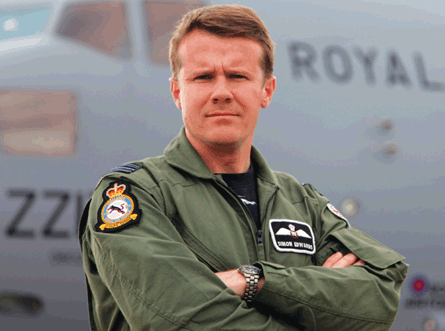Wing Cdr Simon Edwards, commanding officer of the Royal Air Force's single C-17 squadron based at Brize Norton in Oxfordshire, first sampled military flying at school when he joined the Air Cadets
How did you become interested in aviation?
My interest in aviation comes from my father. He would take me to air shows - I remember in particular one at Woodford - from a very early age. Later, I joined the 2486 Air Training Corps when I was at secondary school. My first flight in a Chipmunk was a revelation. To be honest I'm not sure I took any of it in, but I remember the excitement of the event and the "bragging rights" it earned me.
What qualifications/skills do you need for a career as an RAF pilot?
Qualifications have changed over the years. At the moment you need two A-levels or three Highers, together with five GCSEs or equivalent at grade C or better, to include English and mathematics. There are quite a few other requirements (age, nationality and so on). Information is on www.rafcareers.com and the site has a hotline number.
 |
|---|
© Crown Copyright Edwards: the C-17 is an incredible machine |
What was your career path?
I joined the RAF through a sixth-form scholarship scheme, so went to officer training at RAF Cranwell after my A-levels in 1990. Like almost everyone, I was dead set on becoming a fast-jet pilot. Basic flying training on the BAC Jet Provost followed, then the BAE Hawk T1 at RAF Valley. Tactical Weapons School at Chivenor revealed that my "true calling" lay in larger aircraft, so after a brief re-role on BAe Jetstreams, I got my first proper job on 30 Sqn at RAF Lyneham as a co-pilot on the Lockheed Martin C-130K. I was then fortunate to be posted as an instructor at RAF Linton-on-Ouse, flying the Tucano. I was promoted, and after a fascinating job in Headquarters Air Command, I was given the post of flight commander operations on 99 Sqn in 2003. Staff college followed, then a tour in the Ministry of Defence, before I was surprised and delighted to land the post of OC 99. There is no better job.
What's the Boeing C-17 like to fly?
The C-17 is an incredible machine. Although it is huge, nobody remembered to tell the aircraft, and I remember being struck by how much it handles like a Tucano in the circuit. What strikes everyone is its ability to descend at very high rates - we can even place the engines in reverse while flying to really increase the drag - and its landing performance. We recently delivered a giant Sikorsky MH-53 helicopter into RAF Cosford and barely needed half its 1,160m (3,800ft) runway.
What constitutes a typical week's work?
There is no such thing as a typical week so you have to be adaptable. Operationally, we are working on the logistics support concept for Afghanistan to try and make the C-17 airbridge more efficient, particularly now our Iraq missions are becoming less frequent. I then have the challenges of anyone with 250 people working for them - fortunately my executive team are second to none - and I try to squeeze some flying in.
What are the best parts of your job?
The best part is the people. I am continually impressed and amazed with what they achieve. We recently celebrated passing the 50,000 flying hour milestone since the first C-17 arrived in 2001. We continue to deliver assured support to our deployed forces, and never forget that supporting operations is why we are here. Knowing we are making a difference is the next-best part.
And what are the toughest?
The toughest part is resisting the temptation to meddle in my team's business. They are incredibly capable and know what we are trying to achieve. I try to give them direction, then the space they need to deliver.
Does flying still excite you?
The real excitement I suppose comes during the arrival into a threat area, when you need to stay focused to make sure the job gets done. Equally challenging is mission management. The RAF gives its transport pilots fantastic training so that, when they become aircraft captains, we send them away confident they will apply their skill, airmanship and captaincy whatever the task.
Source: Flight International























